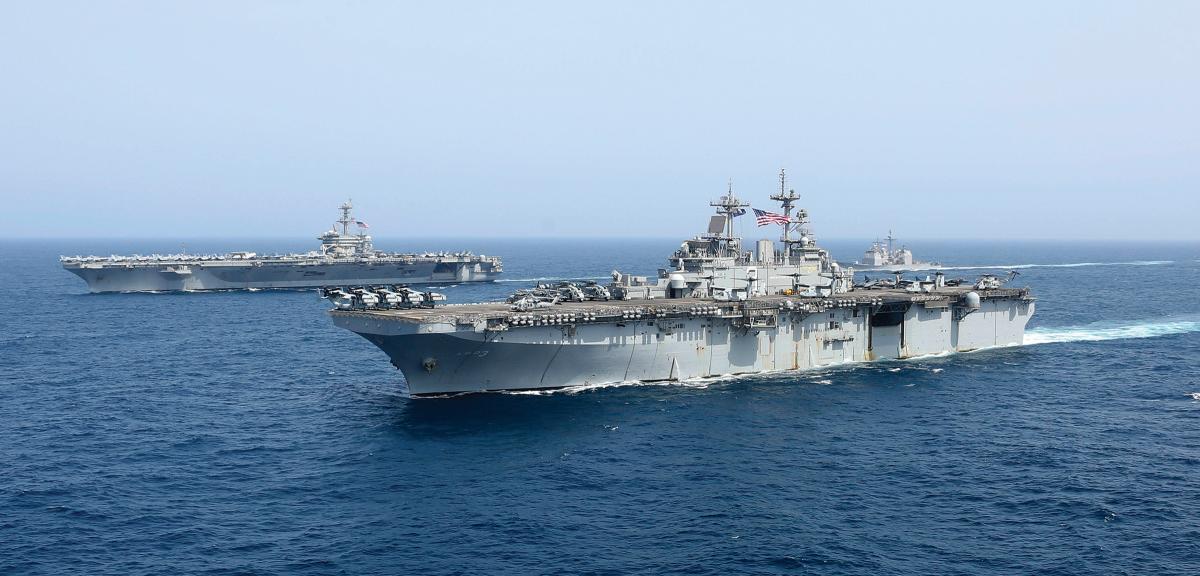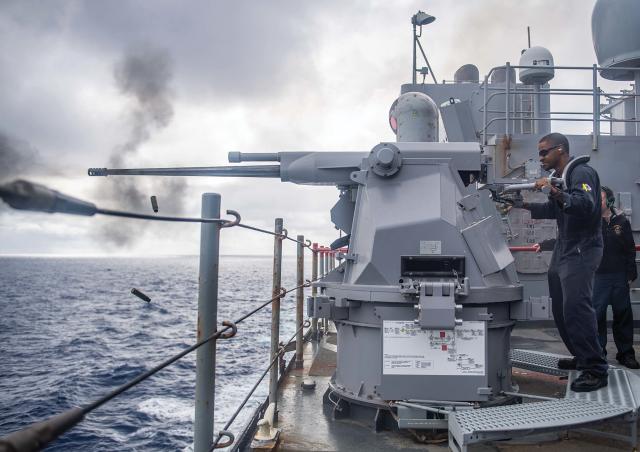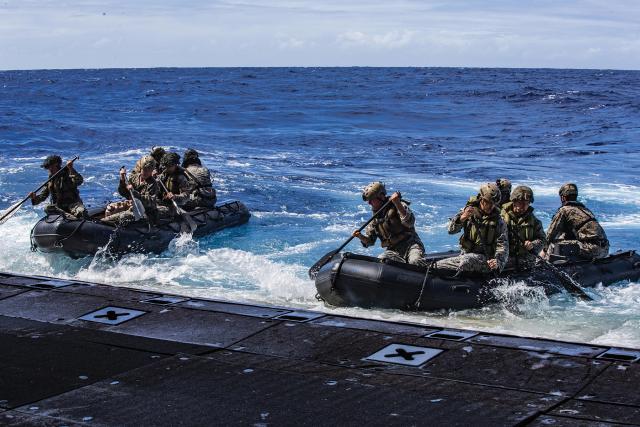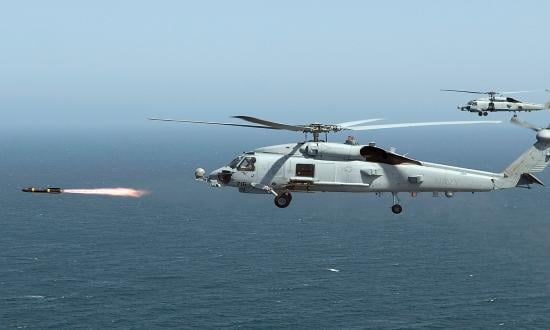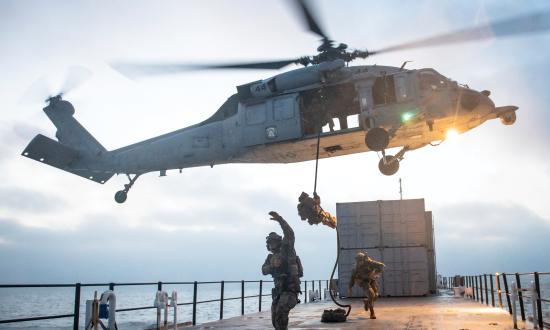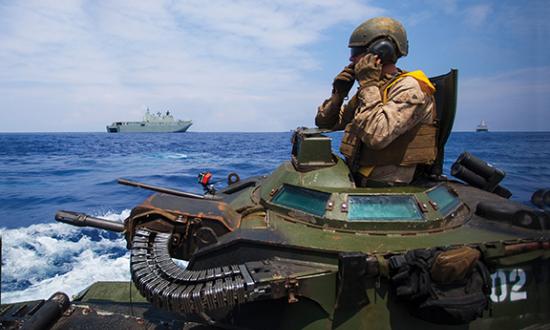Marine Corps Commandant General David H. Berger’s planning guidance calls for the Corps to reemphasize its naval character and more directly support naval operations.1 The main concept to support this shift is expeditionary advanced base operations (EABO), where Marines will seize key littoral terrain and enable the maneuver of Navy ships in contested environments through fires, logistics, and communications support from advanced bases. This will require Marine forces afloat to operate within enemy weapons engagement zones and potentially to conduct contested amphibious operations. The Marine expeditionary unit (MEU) and, eventually, the Marine littoral regiment (MLR) likely will be the units tasked to conduct these seizure and fire missions, and the Navy ship formation currently designed to take them to shore is the amphibious ready group (ARG).
Unfortunately, given peer advances in coastal defense and maritime strike weapons, the traditional three-ship ARG does not possess the requisite combat air power or missile-defense mechanisms to conduct amphibious or littoral operations against well-defended shores. The Navy and Marine Corps can reinvent the ARG structure to be doctrinally integrated within the carrier strike group (CSG) to better enable MEU or MLR operations in contested littorals.
ARG Capabilities
The standard ARG consists of three Navy ships: an amphibious assault ship (LHD/LHA), an amphibious transport dock (LPD), and a dock landing ship (LSD). Together, they can transport more than 2,000 Marines ashore via air or surface connectors in low-threat environments. For long-range strike and air defense, the ARG/MEU team typically relies on six F-35Bs, which carry antiair, but no dedicated antiship, munitions. While the jets are capable of aerial refueling to increase range and on-station times, no viable fueling aircraft can launch from ARG shipping.2
The group’s remaining shipborne weapons are short-range air-defense missile launchers, heavy machine guns for close-in defense, and Sea Sparrow launchers that provide a last line of defense against already-launched incoming missiles. These ship defenses can neutralize threats out to approximately six nautical miles. Long-range land-attack or antiship missiles, such as the Tomahawk or Harpoon, cannot be launched from ARG ships to neutralize land-based threats to shipping and cannot be carried by the F-35B.3
These defenses will be insufficient during amphibious operations in a contested environment, especially in areas actively contested by China. The ability of China’s navy and air force to mass fires against slow-moving naval targets is substantial.4 The DF-series antiship ballistic missiles, for example, can engage ships thousands of miles out to sea, and antiship cruise missiles launched from land, sea, or air can reach hundreds or thousands of miles, depending on the delivery platform.5 Paired with the persistent fighter and bomber air coverage China is able to muster within the first island chain, these threats would require any naval task force attempting to land forces ashore to possess robust and redundant defenses and interception capabilities.6
The U.S. Navy possesses many of these required capabilities, but none are present within an ARG/MEU team. An ARG/MEU alone can defend itself from enemy aircraft out to approximately 400 nautical miles, the radius of its F-35Bs, but a shortage of jets and lack of organic aerial refueling capability would limit this defense in duration and depth. This capability would be minimized further during an active amphibious operation. With the LHD/LHA housing all fixed-wing and most rotary-wing aircraft, the flight deck would struggle to reliably recover and launch aircraft in support of both an amphibious landing and defensive air operations. With troops ashore in need of fire support, those limited assets would be stretched even thinner, limiting the ARG/MEU to using its fighters for close air support or counterair, but likely not both simultaneously.
If threats are able to leak past the F-35Bs, the ARG’s missile defense will rely solely on close-in weapon systems, and the limited number of these systems likely will force the ARG to cease any operations—including the support of Marines ashore—other than self-defense. If under persistent attack from multiple air-, sea-, or land-based missiles, it is unlikely an ARG alone could survive long enough to support contested amphibious operations.7
The Carrier Strike Group
Compared with an ARG, a CSG possesses many more offensive and defensive capabilities, which have made the CSG the primary power-projection formation of the U.S. Navy for the past half-century. The F/A-18 and F-35C, of which a CSG’s carrier has some four dozen, have combat radii hundreds of nautical miles longer than that of the F-35B and can carry air-launched Harpoon antiship missiles. They also are capable of employing farther-reaching land-attack munitions, such as those designed to target land-based fire-control radars for coastal defenses or antiair missiles. The CSG’s organic aerial refueling capability further extends coverage and provides more persistent defense of and support to the naval force. Other aircraft on board the carrier provide enhanced and extended command and control, aerial reconnaissance, and electronic warfare support.8
Other CSG assets also would enable amphibious operations through more massed missile defenses. Cruisers, destroyers, and submarines can target air, surface, and ground threats at greater ranges than assets organic to an ARG. For example, the Tomahawk, able to launch from all three of these platforms, has an engagement range hundreds of nautical miles farther than anything a MEU/ARG can muster organically. Combined with persistent air coverage by capable long-range aircraft, these assets can provide a robust defense, enabling the CSG to support simultaneous operations and distribute capabilities over thousands of square miles.9
If able to benefit from the offensive and defensive capabilities of a CSG, an ARG with a MEU or MLR embarked could survive and operate within much more capable enemy engagement zones. The CSG’s aircraft could provide the more persistent beyond-line-of-sight coverage an ARG would need to flow Marine forces ashore. Enhanced command-and-control infrastructure would enable the more powerful communications assets to share information to enhance situational awareness throughout complex landing operations and land-based fire missions. The fires capabilities of the CSG could prepare landing objectives for the amphibious force, or provide area defense during vulnerable periods of transition from sea to shore. The CSG itself, waiting for the establishment of EABs to enable it to maneuver farther into contested areas, could even have the range to support these Marine forces while keeping assets outside enemy engagement zones, maintaining the Commandant’s vision of the MEU as a “stand-in force” pushing into key areas.10
These capabilities must be available to the ARG if the Marine Corps wants to execute EABO in support of Navy maneuver. It would be extremely difficult to establish EABs in a contested area if the ships carrying the Marine force were unable to enter the area. While the CSG as a whole likely would not collocate with the ARG as it supports the establishment of EABs, portions of its superior weapons coverage could provide ranged defensive coverage.11 Once EABs and their fires capabilities were established, the Navy force would be able to enter the contested area under their protection.
A New Command-and-Control Relationship
For the ARG to be effectively tied to the capabilities and maneuvers of the CSG, a change in their command-and-control relationship will be required. Currently, the ARG and CSG are organized separately under the same fleet commander, as naval task forces. For example, the ARG under Seventh Fleet is CTF-76, while the CSG under that same commander is CTF-70.12 Each force is capable of supporting the other, but the command relationships are not optimized for tying the needs and missions of one to the other. If the CSG and EAB are meant to complement one another, a more direct approach may be needed.
Ideally, the ARG/MEU would integrate within the CSG composite warfare commander (CWC) organization as a subordinate commander. This new commander, potentially termed the amphibious force commander (AFC), would be responsible for all things related to amphibious operations and the establishment of EABs, including working with the other subordinate commanders for fires in support of the landing, air and missile defense of the amphibious force, and fires from the EABs once established. The ARG and Marine force would know that all available capabilities of the CSG were at their disposal, and the CSG would be better able to coordinate the actions of EABs with its own maneuvers. True integration that would enable survivability and lethality against peer adversaries would require this level of coordination and unity of command and control.13
Possibly the strongest potential argument against this reorganization is that many of the issues raised here have been dealt with by the establishment of expeditionary strike groups (ESGs), where a more capable surface combatant is attached to an ARG/MEU to make it more survivable and capable against advanced threats. While an ESG certainly improves the ARG’s ability to defend itself and conduct surface fires, it cannot match the capability that an entire carrier air wing, submarines, and multiple surface combatants bring to bear.
In a situation where an ARG and destroyer would be capable of establishing an EAB alone, the CSG commander could create a temporary subordinate task force to achieve that objective if all assets were under his or her command. However, the opposite would not be as simple. Under the current system, an ESG in need of additional resources would need to look outside its immediate chain of command to get support from a CSG, an adjacent unit. It is better to train for the higher-end threat and scale down when possible, than train for the lower-end threat and need to create new relationships in contingencies.
Another potential argument is that a reorganization could diminish the flexibility of an ARG/MEU to undertake humanitarian crisis and natural disaster response or other lower-threat situations. However, an ARG still could be tasked separately if needed. This tasking could come either from the CSG commander or directly from the fleet commander with the creation of a separate task force. Again, it is much easier to detach smaller groups for smaller-scale missions than rapidly create new ones prior to larger-scale operations.
Finally, this restructuring would not negate Navy and Marine Corps efforts to make the ARG/MEU and MLR more survivable in their own right, nor would it minimize the differing roles of the MEU and MLR. It would simply increase survivability with existing platforms and organizations, while newer systems are being developed and tested. Improved antiair, electronic warfare, and communications capabilities, as well as new ships and Class I unmanned aerial systems, are certainly needed in the long term to maintain the ability of the MEU and MLR to contest key littoral terrain. However, many of those developments are years away. Even the MLR, which will provide much-needed capabilities, still is far from becoming an operational reality.14
The proposed reorganization is possible with limited changes in command structure, equipment, or personnel and therefore could occur more rapidly. As new units and platforms come online, they could be used to supplement or replace assets in the new system.
To fight effectively within contested areas, establish advanced bases, and support Navy objectives, the Marine Corps should change the way it task-organizes to conduct amphibious operations. While the integration of new capabilities or the creation of new units may happen in years to come, more rapid organizational changes can bridge gaps in the short term. Integrating the ARG and its embarked Marines into the CWC structure of a CSG will increase survivability and lethality to support ship-to-shore movements in contested littorals, establishment of advanced bases, and reliable and flexible support to the joint force.
1. Gen David H. Berger, USMC, Commandant’s Planning Guidance: 38th Commandant of the Marine Corps (Headquarters, U.S. Marine Corps, July 2019), 2.
2. Lockheed Martin, “F-35B: The World’s Most Advanced Fighter” (2019), 2.
3. “Ship Self-Defense for LHA-6,” FY17 Navy Programs, U.S. Navy.
4. Christian Brose, The Kill Chain (New York: Hachette Books, 2020), 164.
5. Ron Christman, China’s Second Artillery Force: Capabilities and Missions for the Near Seas (China Maritime Studies Institute, 2014), 37.
6. CAPT Wayne Hughes and RADM Robert Girrier, USN (Ret.), Fleet Tactics and Naval Operations, 3d ed. (Annapolis, MD: Naval Institute Press, 2018), 280–84.
7. Toshi Yoshihara and James Holmes, Red Star Over the Pacific, 2d ed. (Annapolis, MD: Naval Institute Press, 2018), 237.
8. Sam LaGrone, “The Basics: Inside the Carrier Air Wing,” USNI News, 28 April 2016.
9. Commander, Carrier Strike Group 9, “About Us: Reporting Units."
10. Gen David H. Berger, USMC, Force Design 2030 (Headquarters, U.S. Marine Corps, 2020), 5.
11. Hughes and Girrier, Fleet Tactics and Naval Operations, 280–84.
12. Commander, U.S. Seventh Fleet, “Seventh Fleet Task Forces,” www.c7f.navy.mil.
13. CAPT Nick Oltman, USMC, “EABO Needs a New Naval Command and Control Structure,” U.S. Naval Institute Proceedings 145, no. 5 (May 2019).
14. Mallory Shelbourne, “Marine Corps to Stand Up First Marine Littoral Regiment in FY 2022,” USNI News, 20 January 2021; and Megan Eckstein, “Navy Officials Reveal Details of New $100M Light Amphibious Warfare Concept,” USNI News, 19 November 2020.



